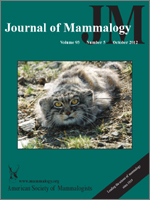We examined intraspecific relationships in the eastern fox squirrel (Sciurus niger) and the eastern gray squirrel (S. carolinensis) using sequence variation in a portion of the mitochondrial DNA cytochrome-b gene and part of the D-loop in the control region. These closely related species are codistributed temperate forest obligates that have similar generation time and population ecologies. For both species, we documented high haplotype diversity, low nucleotide variation, and several groups of divergent haplotypes. However, there is a general lack of spatial structure in maternal lineages within each species. For S. carolinensis, we observed a pattern of population genetic structure that suggests the presence of at least 2 distinct refugial populations that evolved in isolation during the Pleistocene (approximately 98.3–266.3 thousand years ago [kya]) and subsequently expanded to the species' current range following the last glacial maximum. For S. niger, the genetic structure was much less pronounced, with fewer strongly diverged haplotypes. This finding suggests that eastern fox squirrels persisted in either a single population in a glacial refugium or as several refugial populations that maintained gene flow throughout the Pleistocene. For both species, there is evidence that scattered populations were present in multiple, small refugia close to the Laurentide Ice Sheet, allowing rapid range expansion following glacial recession. Taken together, our results indicate that S. niger and S. carolinensis underwent multiple episodes of genetic divergence during isolation in glacial refugia, followed by range expansion and contact that resulted in admixture of divergent maternal lineages within each species during interglacials. Examination of our data further indicates that the most recent range expansion in both species occurred within the past 12–20 kya.
How to translate text using browser tools
1 October 2012
General lack of phylogeographic structure in two sympatric, forest obligate squirrels ( Sciurus niger and S. carolinensis)
Nancy D. Moncrief,
Justin B. Lack,
Jesús E. Maldonado,
Katherine L. Bryant,
Cody W. Edwards,
Ronald A Van Den Bussche
ACCESS THE FULL ARTICLE

Journal of Mammalogy
Vol. 93 • No. 5
October 2012
Vol. 93 • No. 5
October 2012
coalescent
eastern North America
fox squirrel
glacial refugia
Gray squirrel
incomplete lineage sorting
mismatch distribution




